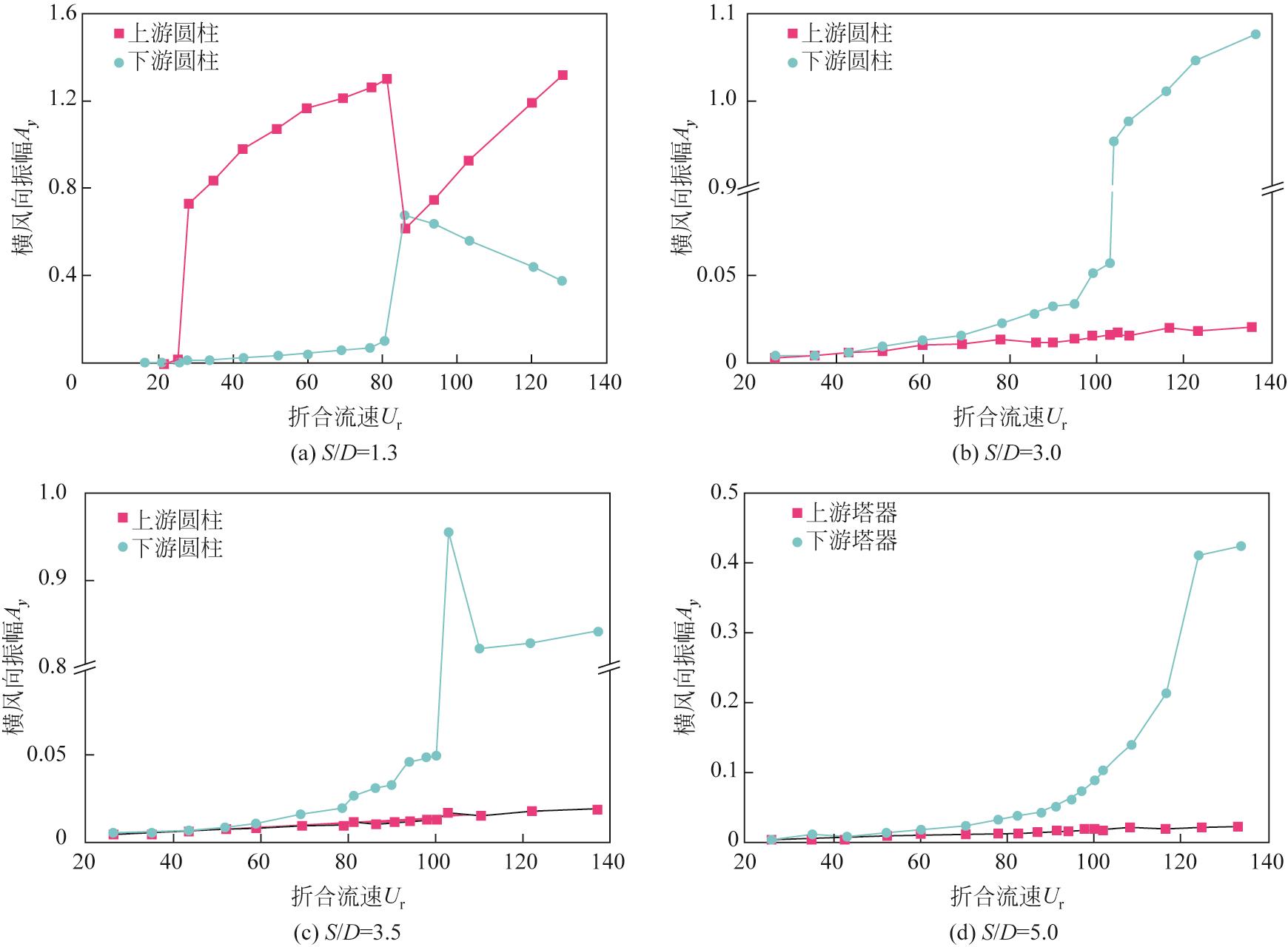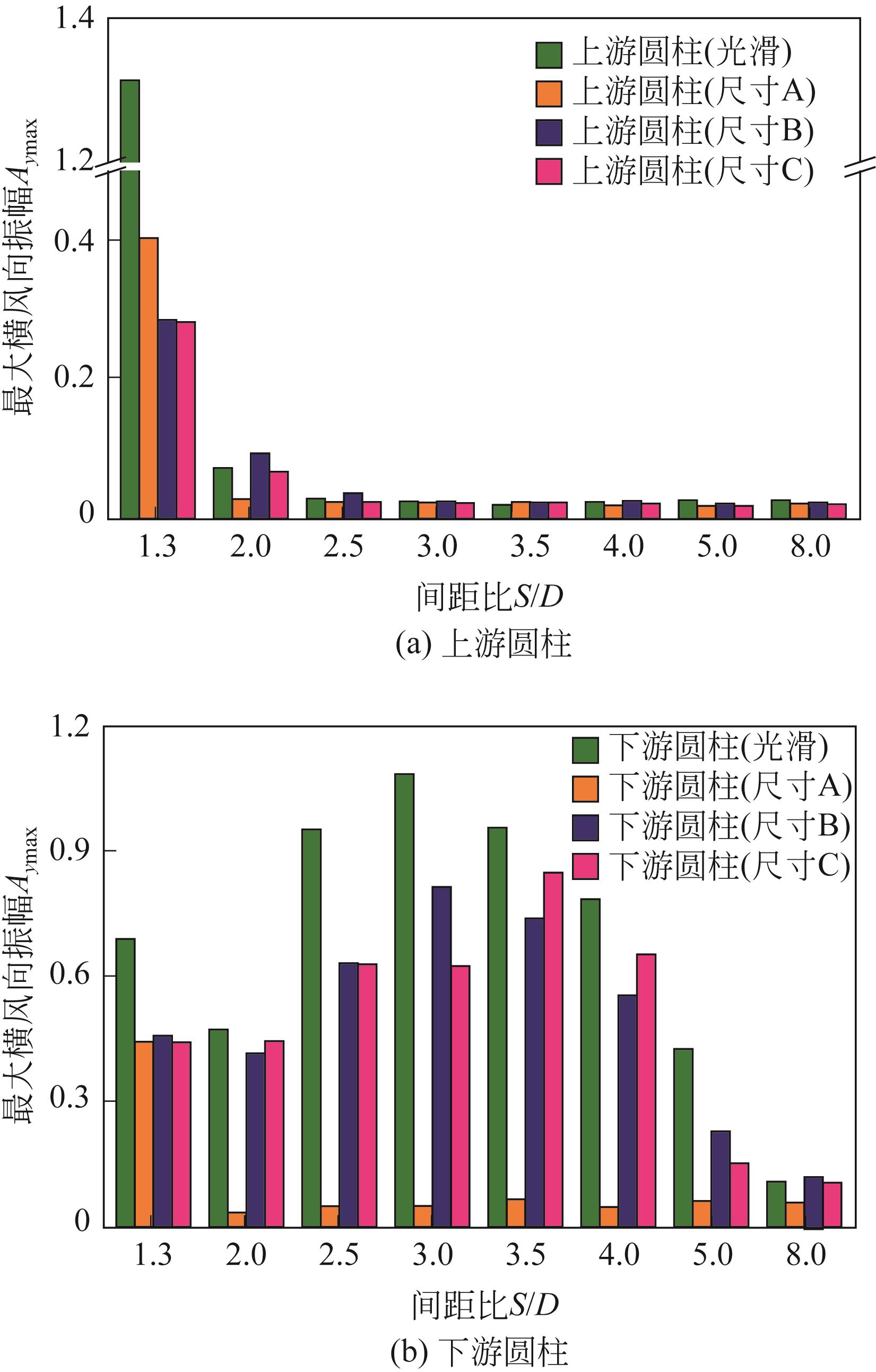Chemical Industry and Engineering Progress ›› 2022, Vol. 41 ›› Issue (4): 1750-1758.DOI: 10.16085/j.issn.1000-6613.2021-0847
• Chemical processes and equipment • Previous Articles Next Articles
Cross-flow vibration characteristics of parallel towers and non-smooth surface vibration reduction
TAN Wei( ), WANG Zhongchen, FAN Xiantao, TANG Bowen
), WANG Zhongchen, FAN Xiantao, TANG Bowen
- School of Chemical Engineering and Technology, Tianjin University, Tianjin 300350, China
-
Received:2021-04-21Revised:2021-05-19Online:2022-04-25Published:2022-04-23 -
Contact:TAN Wei
并排塔器的横风向激振特性与非光滑表面减振
- 天津大学化工学院,天津 300350
-
通讯作者:谭蔚 -
作者简介:谭蔚(1965—),女,教授,博士生导师,研究方向为过程装备流致振动机理与防振技术。E-mail:wtan@tju.edu.cn 。 -
基金资助:国家自然科学基金(21978202)
CLC Number:
Cite this article
TAN Wei, WANG Zhongchen, FAN Xiantao, TANG Bowen. Cross-flow vibration characteristics of parallel towers and non-smooth surface vibration reduction[J]. Chemical Industry and Engineering Progress, 2022, 41(4): 1750-1758.
谭蔚, 王中辰, 樊显涛, 唐博文. 并排塔器的横风向激振特性与非光滑表面减振[J]. 化工进展, 2022, 41(4): 1750-1758.
share this article
Add to citation manager EndNote|Ris|BibTeX
URL: https://hgjz.cip.com.cn/EN/10.16085/j.issn.1000-6613.2021-0847
质量比 (m*) | 固有频率 (fn )/Hz | 阻尼比( | 质量阻尼比(m* | 外径 (D)/mm | 高径比(H/D) | 壁厚 (δ)/mm |
|---|---|---|---|---|---|---|
| 284 | 4.67 | 0.008 | 2.272 | 25 | 16.8 | 2 |
质量比 (m*) | 固有频率 (fn )/Hz | 阻尼比( | 质量阻尼比(m* | 外径 (D)/mm | 高径比(H/D) | 壁厚 (δ)/mm |
|---|---|---|---|---|---|---|
| 284 | 4.67 | 0.008 | 2.272 | 25 | 16.8 | 2 |
| 参数 | 内径 /mm | 厚度 /mm | 尺寸A | 尺寸B | 尺寸C |
|---|---|---|---|---|---|
| 符号 | d | δ | aA×bA×cA | aB×bB×cB | aC×bC×cC |
| 数值 | 26 | 1 | 0.9D×0.1D×0.1D | 0.7D×0.1D×0.1D | 0.9D×0.08D×0.08D |
| 参数 | 内径 /mm | 厚度 /mm | 尺寸A | 尺寸B | 尺寸C |
|---|---|---|---|---|---|
| 符号 | d | δ | aA×bA×cA | aB×bB×cB | aC×bC×cC |
| 数值 | 26 | 1 | 0.9D×0.1D×0.1D | 0.7D×0.1D×0.1D | 0.9D×0.08D×0.08D |
| 流动模式 | 间距比范围 | 间距比取值 |
|---|---|---|
| 单钝体模式 | S/D<2 | 1.3 |
| 剪切层再附着模式 | 2≤S/D<5 | 2.0,2.5,3.0,3.5,4.0 |
| 共同脱涡模式 | S/D≥5 | 5.0,8.0 |
| 流动模式 | 间距比范围 | 间距比取值 |
|---|---|---|
| 单钝体模式 | S/D<2 | 1.3 |
| 剪切层再附着模式 | 2≤S/D<5 | 2.0,2.5,3.0,3.5,4.0 |
| 共同脱涡模式 | S/D≥5 | 5.0,8.0 |
| 8 | ASSI G R S, BEARMAN P W, MENEGHINI J R. On the wake-induced vibration of tandem circular cylinders: the vortex interaction excitation mechanism[J]. Journal of Fluid Mechanics, 2010, 661: 365-401. |
| 9 | KIM S, ALAM M M, SAKAMOTO H, et al. Flow-induced vibrations of two circular cylinders in tandem arrangement. Part 1: Characteristics of vibration[J]. Journal of Wind Engineering and Industrial Aerodynamics, 2009, 97(5/6): 304-311. |
| 10 | QIN B, ALAM M M, ZHOU Y. Free vibrations of two tandem elastically mounted cylinders in crossflow[J]. Journal of Fluid Mechanics, 2019, 861: 349-381. |
| 11 | 张志猛, 及春宁, 许栋, 等. 上游圆柱固定条件下串列三圆柱涡激振动响应和尾流特性[J]. 水动力学研究与进展(A辑), 2019, 34(2): 174-183. |
| ZHANG Zhimeng, JI Chunning, XU Dong, et al. Response and wake characteristics of vortex-induced vibrations of three tandem circular cylinders with the upstream cylinder fixed[J]. Chinese Journal of Hydrodynamics, 2019, 34(2): 174-183. | |
| 12 | 陈威霖, 及春宁, 许栋. 小间距比下串列双圆柱涡激振动数值模拟研究: 振动响应和流体力[J]. 振动与冲击, 2018, 37(23): 261-269. |
| CHEN Weilin, JI Chunning, XU Dong. Numerical simulations for VIVs of two tandem cylinders with small spacing ratios: vibration responses and hydrodynamic forces[J]. Journal of Vibration and Shock, 2018, 37(23): 261-269. | |
| 13 | 陈威霖, 及春宁, 许栋. 小间距比下串列双圆柱涡激振动数值模拟研究: 尾流和耦合机制[J]. 振动与冲击, 2018, 37(23): 270-277, 298. |
| CHEN Weilin, JI Chunning, XU Dong. Numerical simulations for VIV of two tandem cylinders with small spacing ratios: wake flow and interaction mechanism[J]. Journal of Vibration and Shock, 2018, 37(23): 270-277, 298. | |
| 14 | 陈威霖, 及春宁, 许栋, 等. 小直径附加圆柱对圆柱涡激振动抑制的参数优化[J]. 振动与冲击, 2020, 39(3): 24-29, 87. |
| CHEN Weilin, JI Chunning, XU Dong, et al. Parametric optimization for vortex-induced vibration suppression of a single cylinder with two small cylinders symmetrically arranged in rear[J]. Journal of Vibration and Shock, 2020, 39(3): 24-29, 87. | |
| 15 | FAN X T, WANG Z C, WANG Y, et al. The effect of vortices structures on the flow-induced vibration of three flexible tandem cylinders[J]. International Journal of Mechanical Sciences, 2021, 192: 106132. |
| 16 | FAN X T, GUO K, JIA Z B, et al. Vibration mode and velocity interference mechanism of tandem cylinders at subcritical Reynolds number[J]. Journal of Wind Engineering and Industrial Aerodynamics, 2020, 199: 104136. |
| 1 | 路秀林, 王者相. 塔设备[M]. 北京: 化学工业出版社, 2004. |
| LU Xiulin, WANG Zhexiang. Tower Equipment[M]. Beijing: Chemical Industry Press, 2004. | |
| 17 | HUERA-HUARTE F J. Dynamics and excitation in a low mass-damping cylinder in cross-flow with side-by-side interference[J]. Journal of Fluid Mechanics, 2018, 850: 370-400. |
| 18 | 常跃峰, 姜楠, 夏振炎, 等. 沟槽壁湍流减阻机理的氢气泡流动显示及数字图像分析[J]. 天津大学学报, 2009, 42(9): 839-844. |
| CHANG Yuefeng, JIANG Nan, XIA Zhenyan, et al. Hydrogen bubble flow visualization and digital image analysis for drag reduction mechanism in wall turbulence with groove-riblet surface[J]. Journal of Tianjin University, 2009, 42(9): 839-844. | |
| 19 | CHOI J, JEON W P, CHOI H. Mechanism of drag reduction by dimples on a sphere[J]. Physics of Fluids, 2006, 18(4): 041702. |
| 20 | 彭恒, 张荣钢, 杜显赫, 等. 高耸塔器的风振模拟及其采用侧向支撑的减振分析[J]. 压力容器, 2016, 33(1): 25-31. |
| PENG Heng, ZHANG Ronggang, DU Xianhe, et al. Wind induced vibration simulation of high-rise tower and its vibration reduction analysis under lateral supporting[J]. Pressure Vessel Technology, 2016, 33(1): 25-31. | |
| 21 | 郭彦, 杨巧荣, 何文福, 等. 高效耗能阻尼器性能试验及理论研究[J]. 振动工程学报, 2019, 32(5): 757-766. |
| GUO Yan, YANG Qiaorong, HE Wenfu, et al. Experimental and theoretical study of a high damping viscous damper[J]. Journal of Vibration Engineering, 2019, 32(5): 757-766. | |
| 22 | 谭蔚, 陈晓宇, 樊显涛, 等. 摩擦阻尼器对塔器风致振动的减振试验研究[J]. 压力容器, 2020, 37(2): 11-16, 23. |
| TAN Wei, CHEN Xiaoyu, FAN Xiantao, et al. Experimental study on tower vibration reduction of wind-induced vibration with friction damper[J]. Pressure Vessel Technology, 2020, 37(2): 11-16, 23. | |
| 23 | 谭蔚, 杜怡安, 贾占斌, 等. 橡胶阻尼器在底部框架塔中的减振试验研究[J]. 压力容器, 2018, 35(5): 7-12. |
| TAN Wei, DU Yian, JIA Zhanbin, et al. Experimental research on vibration reduction of rubber damper in the bottom frame tower[J]. Pressure Vessel Technology, 2018, 35(5): 7-12. | |
| 24 | 赵昕, 马浩佳, 丁鲲. 超高结构黏滞阻尼系统风振减振优化设计方法[J]. 振动工程学报, 2018, 31(1): 12-19. |
| ZHAO Xin, MA Haojia, DING Kun. Optimal wind-induced vibration attenuation design of viscous damper systems for super tall structures[J]. Journal of Vibration Engineering, 2018, 31(1): 12-19. | |
| 25 | 国家能源局. 《塔式容器》标准释义与算例: NB/T 47041—2014 [S]. 北京: 新华出版社, 2014. |
| National Energy Bureau of the People’s Republic of China. Vertical vessels supported by skirt: NB/T 47041—2014 [S]. Beijing: Xinhua Publishing House, 2014. | |
| 26 | FAN X T, WANG Z C, CHEN X Y, et al. Experimental investigation on flow-induced vibration of flexible multi cylinders in atmospheric boundary layer[J]. International Journal of Mechanical Sciences, 2020, 183: 105815. |
| 27 | 中华人民共和国工业和信息化部. 化工装置设备布置设计规定: [S]. 北京: 中国计划出版社, 2010. |
| Ministry of Industry and Information of the People’s Republic of China. Design specification of equipment layout for chemical plant: [S]. Beijing: China Planning Press, 2010. | |
| 28 | 中华人民共和国工业和信息化部. 石油化工工艺装置布置设计规范: [S]. 北京: 中国石化出版社, 2011. |
| Ministry of Industry and Information of the People’s Republic of China. Specification for design of process plant layout in petrochemical engineering: [S]. Beijing: China Petrochemical Press, 2011. | |
| 2 | 谭博仁, 李龙祥, 王勇, 等. 萃取塔数学模型及过程强化的若干研究进展[J]. 化工进展, 2020, 39(6): 2284-2293. |
| TAN Boren, LI Longxiang, WANG Yong, et al. Progress of solvent extraction column model and process intensification[J]. Chemical Industry and Engineering Progress, 2020, 39(6): 2284-2293. | |
| 3 | 陈颢, 从海峰, 何林, 等. 进料组成对中部蒸汽压缩两段式精馏塔节能与经济效益的影响[J]. 化工进展, 2020, 39(12): 5042-5048. |
| CHEN Hao, CONG Haifeng, HE Lin, et al. Influence of feed compositions on energy-saving and economic benefit of the novel middle vapor recompression distillation column[J]. Chemical Industry and Engineering Progress, 2020, 39(12): 5042-5048. | |
| 4 | 刘雪刚, 何畅, 张民康, 等. 考虑热力学目标的进料分流预热精馏塔分析优化[J]. 化工进展, 2017, 36(5): 1612-1618. |
| LIU Xuegang, HE Chang, ZHANG Minkang, et al. Analysis and optimization of distillation columns with feed splitting and preheating by considering a thermodynamic target[J]. Chemical Industry and Engineering Progress, 2017, 36(5): 1612-1618. | |
| 5 | IGARASHI T. Characteristics of the flow around two circular cylinders arranged in tandem: 1st report[J]. Bulletin of JSME, 1981, 24(188): 323-331. |
| 6 | IGARASHI T. Characteristics of the flow around two circular cylinders arranged in tandem: 2nd report, unique phenomenon at small spacing[J]. Bulletin of JSME, 1984, 27(233): 2380-2387. |
| 7 | ASSI G R S, BEARMAN P W, CARMO B S, et al. The role of wake stiffness on the wake-induced vibration of the downstream cylinder of a tandem pair[J]. Journal of Fluid Mechanics, 2013, 718: 210-245. |
| [1] | LI Chunli, HAN Xiaoguang, LIU Jiapeng, WANG Yatao, WANG Chenxi, WANG Honghai, PENG Sheng. Research progress of liquid distributors in packed columns [J]. Chemical Industry and Engineering Progress, 2023, 42(9): 4479-4495. |
| [2] | TAO Mengqi, LIU Meihong, KANG Yuchi. Analysis of fluid across a single cylinder and two parallel cylinders in a micro flow channel by micro-PIV [J]. Chemical Industry and Engineering Progress, 2023, 42(6): 2836-2844. |
| [3] | WANG Long, LIU Yongfeng, BI Guijun, SONG Jin’ou. Characteristics of diesel combustion under CO2/O2 atmosphere by quantum chemistry calculations [J]. Chemical Industry and Engineering Progress, 2022, 41(6): 2948-2958. |
| [4] | YUE Meng, ZHENG Qiong, YAN Jingwang, ZHANG Huamin, LI Xianfeng. Progress in flow field structure design and optimization for flow battery [J]. Chemical Industry and Engineering Progress, 2021, 40(9): 4853-4868. |
| [5] | Chunli LI, Cong DUAN. Review of CTST: a high-efficient tray [J]. Chemical Industry and Engineering Progress, 2020, 39(6): 2262-2275. |
| [6] | Ao ZHOU, Xiteng LI, Xinpei LI, Shaohua JU, Lihua ZHANG. Extraction and separation of In3+ and Fe3+ using a 3D printing multi-channel microreactor [J]. Chemical Industry and Engineering Progress, 2019, 38(05): 2093-2102. |
| [7] | DING Jichao, HE Lidong, JI Peiyao, ZHANG Lihao. Application of damping vibration reduction for pipeline of rich gas compressor [J]. Chemical Industry and Engineering Progress, 2018, 37(S1): 229-234. |
| [8] | JIAO Qianfeng, MA Youfu, LÜ Junfu, CAI Zhenqi, PENG Jiewei, SUN Xuanju. Comparison of experiment with correlation on pressure drop of multi-orifice plates [J]. Chemical Industry and Engineering Progress, 2018, 37(09): 3320-3325. |
| [9] | JING Jiaqiang, QI Hongyuan, LIANG Aiguo, SHI Jianying, JIANG Huayi, ZHANG Yixiang, WANG Yulong, SUN Nana. Experimental research on the effect of pipe surface wettability on flow resistance in laminar flow [J]. Chemical Industry and Engineering Progress, 2017, 36(09): 3203-3209. |
| [10] | WANG Bin, ZHU Kai, WANG Yabo, LIU Shengchun, WEI Jie. Experimental study on cooling and flow performance of water-cooling radiator with different pin-fins structures for CPU cooling [J]. Chemical Industry and Engineering Progress, 2017, 36(06): 2031-2037. |
| [11] | DING Rui, MAO Zeyu, WANG Jianlong. A review on the water treatment reactor by electron beam [J]. Chemical Industry and Engineering Progree, 2017, 36(02): 410-417. |
| [12] | ZHANG Pan, DUAN Jihai, WANG Weiwen, CHEN Guanghui, LI Jianlong. Process intensification based on fully mixed and evenly distributed method:practice in Qingdao University of Science and Technology [J]. Chemical Industry and Engineering Progree, 2016, 35(10): 3016-3021. |
| [13] | ZHANG Hongxu, CAI Lianbo, WANG Qiang, CHEN Qiang, ZHOU Mingdong, ZANG Shuliang. Hydrodynamic performance of a gas-liquid distributor in fixed bed reactors [J]. Chemical Industry and Engineering Progree, 2016, 35(07): 1975-1979. |
| [14] | ZHAO Shufang, BAI Lin, FU Yuhang, JIN Yong, CHENG Yi. Fundamental research and applications of droplet-based microreactor [J]. Chemical Industry and Engineering Progree, 2015, 34(3): 593-607,616. |
| [15] | WAN Dongyu, WANG Shengwei, CHEN Shuangxi, WANG Yuqiang. Research progress and prospective of three-phase inverse fluidized bed [J]. Chemical Industry and Engineering Progree, 2015, 34(02): 303-311,318. |
| Viewed | ||||||
|
Full text |
|
|||||
|
Abstract |
|
|||||









